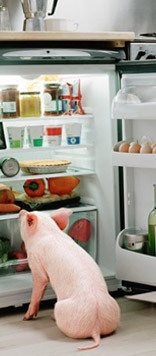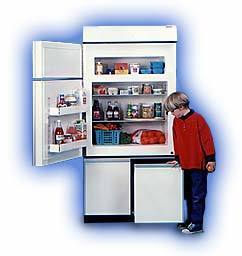
According to National Geographic’s Green Guide, our refrigerators are probably the biggest energy hogs in our homes. What to do? Well, if a new refrigerator is in our future, it’s best to shop for an Energy Star rated refrigerator, which use at LEAST 20% less energy than federal standards. The most energy efficent refrigerator on the market right now is the Sun Frost RF-12, pictured below. It is a whopping 51% more efficient and federal standards dictate. However, at $2,279 a pop, it may not be affordable to all.

Not to worry. ALL Energy Star Rated refrigerators use about HALF as
much energy as those manufactured before 1993. A great resource to help us through the process of investing in a new fridge is energystar.gov, which has a manufacturers list, purchasing tips and even refrigerator savings calculators. However, if buying a brand new refrigerator is NOT in our future, we can make the old one a little less energy-hoggy by following these tips from The Green Guide:
-
Don’t keep your fridge too cold.
Refrigerators should be kept between 37 and 40 degrees and freezers at
5 degrees. Colder temperatures waste energy. To test the temperature,
leave an appliance thermometer in a glass of water in the middle shelf
for 24 hours. In the freezer, place a thermometer among packs of frozen
food. -
Clean the coils annually.
-
Cover food and drink to avoid evaporation in the fridge, which can force the compressor to work harder.
-
Keep your freezer filled. Frozen blocks of food keep freezer temperatures more stable.
-
Don’t clutter the fridge top; it can hamper the compressor’s proper air circulation.
-
Don’t put your refrigerator in direct sunlight or next to an oven or dishwasher.
-
Check the door seals. They should be able to hold a piece of paper in place.
-
Defrost the freezer regularly and avoid frost build-ups of more than a quarter-inch.
Piggy picture courtesy of energyhog.org.